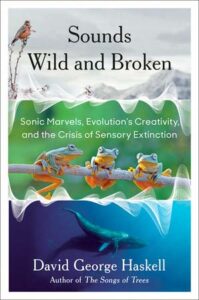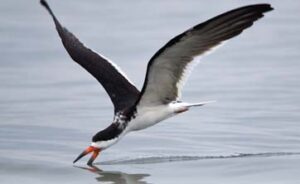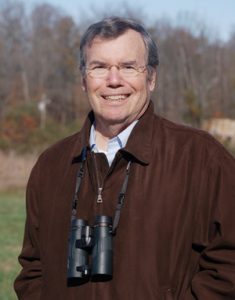Rachel Carson, David George Haskell, and the Sounds of Silence
David George Haskell, Sounds Wild and Broken: Sonic Marvels, Evolution’s Creativity, and the Crisis of Sensory Extinction (New York: Viking, 2022)
 The similarities between Rachel Carson and David George Haskell seem simple, obvious. The opening fable of Silent Spring limns a once idyllic American town now deserted and silent. In this once pastoral scene, echoing Keats’ line, “no birds sing.” In Sounds Wild and Broken, Haskell, too, warns of a world without bird song.
The similarities between Rachel Carson and David George Haskell seem simple, obvious. The opening fable of Silent Spring limns a once idyllic American town now deserted and silent. In this once pastoral scene, echoing Keats’ line, “no birds sing.” In Sounds Wild and Broken, Haskell, too, warns of a world without bird song.
But David George Haskell’s place in the lineage left by Carson, his connection to her, is far richer, more resonant than mere appreciation for bird song, what it might mean, for example, to still the voice of the White-crowned sparrow — brilliantly described by Haskell from Arctic tundra to Tennessee — that has developed regional dialects, even unique individual songs, by listening and learning from other sparrows.
 Carson’s gift to us is found in her keen scientific research and real-life observations, her attentiveness, her wonder, awe and imagination, her empathy for other beings, however small or strange. Such empathy grows from Carson’s sensual awareness, the very awareness that resonates throughout Sounds Wild and Broken.
Carson’s gift to us is found in her keen scientific research and real-life observations, her attentiveness, her wonder, awe and imagination, her empathy for other beings, however small or strange. Such empathy grows from Carson’s sensual awareness, the very awareness that resonates throughout Sounds Wild and Broken.
 Both Haskell and Carson help us transcend the sensory boundaries of our lives and the strictures of society. We have painted too flat an icon of Carson. We picture her boldly testifying to Congress and bravely responding to the corporate critics and scientific hacks who try to smear her character and her science. The word sensual does not spring to mind.
Both Haskell and Carson help us transcend the sensory boundaries of our lives and the strictures of society. We have painted too flat an icon of Carson. We picture her boldly testifying to Congress and bravely responding to the corporate critics and scientific hacks who try to smear her character and her science. The word sensual does not spring to mind.
 Instead, picture a slim, auburn-haired Carson, just thirty, sprawled upon a deserted, wet moonlit beach in North Carolina, her every sense attuned to life and beauty, tingling in the silence. These sensations are captured and enter our bodies, our own senses, through Carson’s carefully wrought words in the opening of Under the Sea-Wind (1941), her first and finest book. A mysterious bird silently wings over the sound and the sand, “the color of steel overlaid with the sheen of silver.” The bird, Rynchops, the Black skimmer, approaches so silently that “the sound of his wings, if sound there were, was lost in the whisper song of the water turning over the shells on wet sand.” Thus, keenly attuned, we can feel sounds outside of the range of human hearing. We identify with Rynchops who feeds by skimming low along the water, slicing it with his outsized bill that sends out “vibrations thudding down through the water to rebound from the sandy bottom.” These sound waves are “received” by blennies and killifish who, thinking them shrimp, are attracted to the surface to be scooped up by Rynchops. This because, “in the fish world many things are told by sound waves.”
Instead, picture a slim, auburn-haired Carson, just thirty, sprawled upon a deserted, wet moonlit beach in North Carolina, her every sense attuned to life and beauty, tingling in the silence. These sensations are captured and enter our bodies, our own senses, through Carson’s carefully wrought words in the opening of Under the Sea-Wind (1941), her first and finest book. A mysterious bird silently wings over the sound and the sand, “the color of steel overlaid with the sheen of silver.” The bird, Rynchops, the Black skimmer, approaches so silently that “the sound of his wings, if sound there were, was lost in the whisper song of the water turning over the shells on wet sand.” Thus, keenly attuned, we can feel sounds outside of the range of human hearing. We identify with Rynchops who feeds by skimming low along the water, slicing it with his outsized bill that sends out “vibrations thudding down through the water to rebound from the sandy bottom.” These sound waves are “received” by blennies and killifish who, thinking them shrimp, are attracted to the surface to be scooped up by Rynchops. This because, “in the fish world many things are told by sound waves.”
Within a few pages, we have entered a realm beneath the waves that, in the 1930’s, could only be imagined. As Carson was writing, there was still scientific debate if fish could even hear (the consensus was still that they could not) let alone communicate or feel things like fear or agony when being caught in a trawler’s fishing net. This extension and expansion of our human senses allows us in Under the Sea-Wind to identify with the lives and the perils of main characters like Scomber, the mackerel, and Anguilla, the eel.
This use of sounds and senses to enter the world of the “other” is the heart of both Carson’s and Haskell’s ecological ethic. Both echo Dr. Albert’s Schweitzer’s “reverence for life.” Carson says, “The more clearly we can focus our attention on the wonders and realities of the universe about us, the less taste we shall have for destruction.” For Carson and Haskell, we must begin with looking and listening, understanding that the sights and sounds of nature and the creatures who make them are the marvelous products of eons of evolution. In her massive best-seller, The Sea Around Us (1951), Rachel Carson takes us back to the beginnings of our solar system, as the moon breaks off from the cooling Earth which continues to solidify, form ancient seas, and the first stirrings of simple, single-celled life.
David George Haskell begins his profound journey through time, space and sound with billions of years of silence on the Earth before there emerges any sound at all – the intracellular motion of ancient bacteria that sent “infinitesimally quiet murmurs, sighs, and purrs into their watery surroundings.” Haskell can take us through the evolution of the Earth, its beings, and their sounds, because of the immense leaps in scientific technology in the eighty years since Under the Sea Wind was first published. We can listen to and lean from bacteria only because of the most sensitive modern microphones and audio amplification in a laboratory, or by lasers that track and measure the crests and troughs of the cell’s sound waves that are about five nanometers — half a million times smaller than the deflections of vocal folds when humans speak.
 Despite his ease with advanced technologies that allow him and us to penetrate galaxies, listen to the depths of the ocean, and recreate continents and soundscape on computer screens, Gaskell never lets us forget the connection of these high tech “experiences” to the real thing, our bodily, sensate selves. Like Rachel Carson upon the beach along the Outer Banks, Gaskell, too, lies prostrate on a wooden dock along the salt marshes of Saint Catherines Island on the Georgia coast. His body, his senses are alert, attuned. Like Carson, he is listening, but through headphones connected to a hydrophone three meter deep in turbid, opaque water. First there is a high gurgle of streaming water, but “Suddenly I’m plunged into a pan of sizzling bacon fat. Sparkles surround me, a sonic shimmer. Every glistening fragment is a fleck of sunlit copper, warm and flashing. I’ve arrived in the domain of snapping shrimp.” Gaskell listens to strange knocking sounds “like an impatient fingernail drumming on a hardcover book, sharp and low, with a touch of resonance.” These come from finger-length silver perch. There are also “faster bursts of tapping, almost purrs,” from Atlantic croaker and then “Waa!” The bleat of a lamb, but quieter, from oyster toadfish, “scaleless and warty, with huge, gulping mouths.”
Despite his ease with advanced technologies that allow him and us to penetrate galaxies, listen to the depths of the ocean, and recreate continents and soundscape on computer screens, Gaskell never lets us forget the connection of these high tech “experiences” to the real thing, our bodily, sensate selves. Like Rachel Carson upon the beach along the Outer Banks, Gaskell, too, lies prostrate on a wooden dock along the salt marshes of Saint Catherines Island on the Georgia coast. His body, his senses are alert, attuned. Like Carson, he is listening, but through headphones connected to a hydrophone three meter deep in turbid, opaque water. First there is a high gurgle of streaming water, but “Suddenly I’m plunged into a pan of sizzling bacon fat. Sparkles surround me, a sonic shimmer. Every glistening fragment is a fleck of sunlit copper, warm and flashing. I’ve arrived in the domain of snapping shrimp.” Gaskell listens to strange knocking sounds “like an impatient fingernail drumming on a hardcover book, sharp and low, with a touch of resonance.” These come from finger-length silver perch. There are also “faster bursts of tapping, almost purrs,” from Atlantic croaker and then “Waa!” The bleat of a lamb, but quieter, from oyster toadfish, “scaleless and warty, with huge, gulping mouths.”
Gaskell finds all these previously inaudible sounds as strange, different than the “melodies, timbres and rhythms of humans, birds, and insects.” But there is unity between them and us since sound stimulates the shrimps’ “stretch receptors…where cilia transmit motion to nerves.” These are the same cilia that through evolution appeared first in single-celled organisms and now allow hearing in the human ear. This appreciation for evolution and the role that sound has played in shaping it creatively leads Gaskell to the development of music and aesthetics among humans.
 After learning about them in a German museum, Gaskell travels to archeological sites to play the earliest known human instruments – flutes carved by humans out of Griffon vulture bones and mammoth ivory some 40,000 years ago. He uses audio instruments and a trained musical ear to listen and discover that the most resonant spots for Paleolithic flute music match the sites in caverns where there are paintings, carvings, and other signs of artistic or religious performances. But as Gaskell purses and blows and puffs to get sound out of an ancient flute, we are reminded that even aesthetic pleasure has its roots deep in the sensations of the evolved human body.
After learning about them in a German museum, Gaskell travels to archeological sites to play the earliest known human instruments – flutes carved by humans out of Griffon vulture bones and mammoth ivory some 40,000 years ago. He uses audio instruments and a trained musical ear to listen and discover that the most resonant spots for Paleolithic flute music match the sites in caverns where there are paintings, carvings, and other signs of artistic or religious performances. But as Gaskell purses and blows and puffs to get sound out of an ancient flute, we are reminded that even aesthetic pleasure has its roots deep in the sensations of the evolved human body.
 In a masterful display of sensual, descriptive writing, Gaskell takes us to a concert at Lincoln Center in New York where “the plaza has been stripped of all signs of non-human life” – from the fountains and stones outside to the sealed, hushed, air-controlled interior where the assembled audience sits silently as musicians dressed in formal black enter to await the opening baton thrust of the maestro, Jaap van Zweden. Gaskell says, “The experience of sound here will, it seems, transcend this time and place, focusing our attention on a sonic experience of creativity, artistry and beauty unshackled from Earth.” But this escape, he reminds us, “is an illusion.” From the moment the oboe sounds, “forests and wetlands come alive on stage…our senses immersed in the physicality of plants and animals” from whence come the wood and reeds that produce the sound of the oboe.
In a masterful display of sensual, descriptive writing, Gaskell takes us to a concert at Lincoln Center in New York where “the plaza has been stripped of all signs of non-human life” – from the fountains and stones outside to the sealed, hushed, air-controlled interior where the assembled audience sits silently as musicians dressed in formal black enter to await the opening baton thrust of the maestro, Jaap van Zweden. Gaskell says, “The experience of sound here will, it seems, transcend this time and place, focusing our attention on a sonic experience of creativity, artistry and beauty unshackled from Earth.” But this escape, he reminds us, “is an illusion.” From the moment the oboe sounds, “forests and wetlands come alive on stage…our senses immersed in the physicality of plants and animals” from whence come the wood and reeds that produce the sound of the oboe.
It is from the orchestra that “we experience a direct connection not only to the distant stories of ear bone evolution but also to the living presence of animal sensuality.” Here the pleasure of music is produced and felt by bodies. “Fingertips brush, press, and slide along strings. Cellos stir the skin and muscles of inner thighs. Reeds tremble between wet lips. Breath flows across the open mouths of flutes. Hands, arms, and shoulders pound tympani and send shudders through maracas. Lungs cry out through trembling lips, their agitations shaped and amplified by brass coils soaked through on the inside with the moisture of human breath.”
 We have evolved into maestros of the Earth who can delight in beauty or destroy it. Our enhanced capabilities created fast ships, exploding harpoons, and sonar tracking allowing us to decimate whale populations until 1970 when, following decades of technological innovation in hydrophones by the U.S. Navy, Roger Payne released Songs of the Humpback Whale, a sort of audio Silent Spring. The collection of haunting cries and moans quickly sold over a million copies, reached ten million more through inclusion in the National Geographic, made the pages of Science, was mixed into Judy Collins’s “Farewell to Tarwathie,” performed by the New York Philharmonic in the music of Alan Hovhaness, and played as testimony for whale conservation in the U.S. Congress. As Gaskell tells it, “The humpback’s songs fell on ears ready for an emotionally charged expression of both despair at destruction and hope for the future.”
We have evolved into maestros of the Earth who can delight in beauty or destroy it. Our enhanced capabilities created fast ships, exploding harpoons, and sonar tracking allowing us to decimate whale populations until 1970 when, following decades of technological innovation in hydrophones by the U.S. Navy, Roger Payne released Songs of the Humpback Whale, a sort of audio Silent Spring. The collection of haunting cries and moans quickly sold over a million copies, reached ten million more through inclusion in the National Geographic, made the pages of Science, was mixed into Judy Collins’s “Farewell to Tarwathie,” performed by the New York Philharmonic in the music of Alan Hovhaness, and played as testimony for whale conservation in the U.S. Congress. As Gaskell tells it, “The humpback’s songs fell on ears ready for an emotionally charged expression of both despair at destruction and hope for the future.”
The humpback was saved and has rebounded, but destruction continues. Gaskell describes the pollution of the seas and land, the devasting effects of climate change, the loss of species, and the growing global devastation of the world’s natural sounds in cities and suburbs. Yet we can still hear the sensuous sounds of nature that connect us to other beings and ourselves in ways previously and literally unheard of — if we but listen and feel. We are beings who have evolved into both technological dominance and a love of beauty, of wonder, imagination, and feeling, much of it stimulated by sound. As Rachel Carson said, drawing on her own sensual understanding of nature and of love for others, “it is more important to feel than to think.” With David George Haskell’s Sounds Wild and Broken, Rachel Carson’s work has been extended, deepened, amplified, and given birth to this progeny worthy of our perilous times.
— Bob Musil
 Bob Musil is the President and CEO of the Rachel Carson Council, a baritone singer, and former Executive Producer and host of the nationally-syndicated radio program, Consider the Alternatives. He is the author of Rachel Carson and Her Sisters: Extraordinary Women Who Have Shaped America’s Environment and editor, with his Introduction and annotations, to the Rutgers University Press illustrated edition of Rachel Carson’s Under the Sea-Wind.
Bob Musil is the President and CEO of the Rachel Carson Council, a baritone singer, and former Executive Producer and host of the nationally-syndicated radio program, Consider the Alternatives. He is the author of Rachel Carson and Her Sisters: Extraordinary Women Who Have Shaped America’s Environment and editor, with his Introduction and annotations, to the Rutgers University Press illustrated edition of Rachel Carson’s Under the Sea-Wind.






